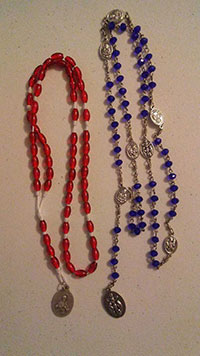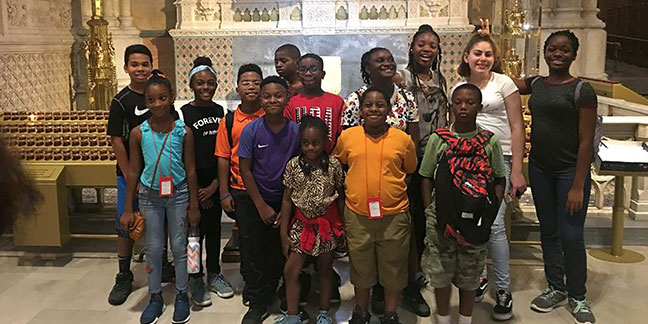 ASHEBORO — Rosary maker Joe McGinty admits he went through a dark period in his life after he left the U.S. Marine Corps seven years ago. He was deployed six times during the eight years he served, and like many veterans, he struggled with post-traumatic stress disorder, substance abuse and alcoholism after his return.
ASHEBORO — Rosary maker Joe McGinty admits he went through a dark period in his life after he left the U.S. Marine Corps seven years ago. He was deployed six times during the eight years he served, and like many veterans, he struggled with post-traumatic stress disorder, substance abuse and alcoholism after his return.
But the Blessed Mother did not abandon him – thanks to the devotion of McGinty’s mother Eileen.
Pictured: Mother and son, Eileen and Joe McGinty, make thousands of rosaries each year to share with people near and far. Joe, a U.S. Marine Corps veteran, finds rosary making therapeutic since coming home from active duty. (SueAnn Howell | Catholic News Herald)
A retired nurse and a parishioner of Our Lady of Grace Church in Greensboro, she is a devoted Catholic who over the years has made at least 10,000 rosaries that have been sent around the world to help others grow in faith, hope and love.
“A couple years ago, my mom got me to start praying the Divine Mercy Chaplet every day at 3 o’clock,” McGinty explains. “I started doing that and then I felt the desire to start praying the rosary. At the time I started praying the rosary, I got a fire in me to start making rosaries.
“I started learning how to make them and I found it to be extremely therapeutic. I couldn’t put them down. I learned how to make the cord rosaries. Then I got my mom to teach me how to make the metal ones. It just went from there. I got hooked on it.”
Now he focuses on making Seven Sorrows rosaries in honor of Our Lady of Sorrows. The Seven Sorrows devotion dates back to as early as the 13th century and is attributed in part to writings of St. Brigid of Sweden. The devotion was brought into the spotlight more recently in the 1990s due to the genocide in Rwanda, where Our Lady of Kibeho appeared to young Catholics urging them to pray the Seven Sorrows rosary to ward off impending violence.

 Immaculee Ilibagiza, a survivor of the Rwandan genocide who prayed the rosary repeatedly throughout the 91 days she spent in hiding, now travels the world speaking about her experiences and the power of the rosary and the Seven Sorrows rosary devotion.
Immaculee Ilibagiza, a survivor of the Rwandan genocide who prayed the rosary repeatedly throughout the 91 days she spent in hiding, now travels the world speaking about her experiences and the power of the rosary and the Seven Sorrows rosary devotion.
McGinty was moved by Ilibagiza’s story when his mother took him to see her when she visited the Diocese of Charlotte.
“I heard her story and brought one of her Seven Sorrows rosaries. It sat around the house (at first) and I didn’t pray it. Something in my head kept saying, ‘pray it,’ and one day I asked my parents where the rosary was and I started praying it.”
He felt the urge to start making Seven Sorrows rosaries. He leaves baskets full of 40 rosaries each in local churches for parishioners to take. In each rosary bag he places a pamphlet in English or Spanish explaining the history of the rosary, the devotion to the Seven Sorrows rosary and Our Lady’s promises to those who pray it.
McGinty quickly realized that many Catholics have never heard of the Seven Sorrows rosary. He has been met with skepticism but he keeps making and distributing them.
“We make these rosaries because of our devotion to the Blessed Virgin Mary,” Eileen says. “We make them and send them to missionaries for free and would eventually like to teach other churches how to produce and disseminate these rosaries, so everyone can be a spiritual bladesmith. In these times, everyone needs to be armed with the most powerful and effective spiritual sword against evil – that is, the rosary.”
She and her son also credit the Holy Spirit for their devotion to the rosary.
“When prayed devoutly, it can combat many of today’s immoralities and injustices,” McGinty says. “The Blessed Virgin appeared twice in apparitions requesting this specific devotion to be prayed for a reason: it’s powerful and effective.”
— SueAnn Howell, senior reporter
 CHARLOTTE — More than 30 young people from Our Lady of Consolation Parish’s Youth-In-Action group went on a five-day, coming-of-age road trip all the way to “Kujenga.”
CHARLOTTE — More than 30 young people from Our Lady of Consolation Parish’s Youth-In-Action group went on a five-day, coming-of-age road trip all the way to “Kujenga.”
Kujenga, which means “to build” in Swahili, was a retreat for black Catholic teens held recently outside New York City.
The journey challenged the youths to deepen their Catholic faith, connect to their African American roots, and receive spiritual guidance to help them become strong, young black Catholic adults.
Youth chaperone Dominise Duliepre explained, “Yes, we had fun, but the whole point was to get in touch with our spiritual side, to understand why we are here and what other people are doing. How do we all connect as one family? It is great to see other young black Catholics because we do not see them very often, especially in Charlotte. We are the only black Catholic church in the area. To see black Catholics at other churches in Brooklyn and Queens was cool. Seeing other kids like us sharing a similar religious experience was exciting.”
Their journey included a brief stop in Washington, D.C., where they visited the White House and the Washington Monument as well as the National Museum of African American History and Culture. YIA member and leader Emmanuel Okechukura, 19, said, “The first stop was the African American Museum, which is very famous. It was established in 2017. We re-established a lot of history there, connecting to our roots.”
Trip organizer and youth coordinator Denise Gittens-Duliepre added, “The display of Emmett Till’s coffin was the most impactful and very emotional. To actually see the coffin he laid in, it was as though the clock stopped at the year 1955 and you felt like you were really at the funeral services for Emmett Till. The room was filled with a feeling of overwhelming sadness. Emmett Till was the 14-year-old accused of whistling at a white woman. He was tortured, disfigured and murdered by two white men. There were so many heart-breaking exhibits, but there were also many wonderful historical accomplishments of African Americans, which made YIA proud.”
Their second day was packed with as much adventure as the first. Gittens-Duliepre said, “After a night at the Apollo, YIA started their day off with a visit to the cathedral in Harlem, St. Charles Borromeo Church. The pastor, Father Gregory Chisholm, and his spiritual team did an excellent job sharing and teaching how Catholicism played a major role in the history of Harlem. His spiritual team spoke on the importance of being Catholic and answering to God’s call. This session emphasized the importance of holding on to faith as Catholics while growing older.”
YIA members then attended a special luncheon with civil rights activist Claudette Colvin.
Amily James, 15, said, “We went to see the ‘first Rosa Parks,’ Ms. Colvin. They were trying to make her stand up on the bus but she refused to. We met her at a restaurant, and we ate and we were just listening to her story. It was somewhat touchy and she was funny, inspirational. What will always stick with me is when Ms. Colvin said that while on that bus she felt Harriet Tubman pushing down on one shoulder and Sojourner Truth pushing her down on the other shoulder, which had her glued to that seat.”
Gittens-Duliepre added, “Ms. Colvin opened her talk by praying the Lord’s Prayer with the youth. She made the YIA feel like they were actually there as they could feel the fear, anxiety and ultimately the courage she felt that day.”
“YIA ended day two by riding the NYC subway, which was quite an event. They had 15 minutes of fame when YIA collaborated singing and dancing talents with a NYC street performer at the Times Square Station. It was a magical experience when the street performer unselfishly gave the kids his microphone and shared his train station stage. As the party began with clapping, singing and dancing, immediately a huge audience circled the youth with their phones out to display to the social media world what was happening,” Gittens-Duliepre recalled.
As the young people climbed the stairs up from the train station into the bright lights of 42nd Street, they felt overwhelmed and exhilarated by the huge crowds of people. For some, it was their first time visiting the city.
Jovanka Gonzalez, 13, said, “We went to Times Square and at first it was all fun; we saw all the lights. Most of us who have not been there – we were stunned by everything. Then we started walking around, we started to get adjusted to things. It is a different environment, and we are not used to the crowded places in New York. It was very fun but very alerting for us.”
YIA members also visited St. Patrick’s Cathedral. Jovanka Gonzalez recalled, “Although St. Patrick’s was in the busy streets of Manhattan, when you stepped inside, you could feel peace. We were all surprised to learn that African American St. Pierre Toussaint is buried there.”
Olivia Mukoko, 12, added, “We also went to the 9/11 towers that are actually waterfalls now. There we saw a tree – the only tree that survived 9/11 – and someone talked to us about that tree. I felt that it represented how we should still overcome the bad even though there is a lot of bad coming our way. We should still fight on and not give up, because that tree is still there.”
Friday morning, the YIA crew headed to the dioceses of Brooklyn and Queens and met in fellowship with more than 75 youth from Brooklyn and Queens at their final destination: Kujenga.
The event, held at the Seminary of the Immaculate Conception on Long Island, N.Y., featured presentations by several speakers, Eucharistic Adoration, opportunity for the sacrament of confession, a recitation of the rosary, a lecture on African saints and ancestral prayer rituals, and a rite of passage ceremony for the youths. The event concluded with Sunday Mass.
YIA’s Florence Okoro, 17, recalled, “The Holy Hour was the most memorable experience as we gathered in the church with candles and sang worship songs. I felt so close to God that it moved me to tears. I will forever remember the smell of the incense and the voice of God.”
Jacqueline Diouf, 16, added, “It was dark and candles were lit up. It was kind of like a meditation hour with God. The atmosphere was so spiritual. It was just cool to feel the presence of God all together in a different space. Sometimes you just don’t feel it at your home. Sometimes you just don’t feel it because sometimes you get used to the atmosphere, sometimes it is just not there. But then, when you get with other people, you can really feel. You can talk about it, like, you can talk out loud. I can feel it! I can still feel it right now because we are all here and we are all reminiscing about what we did at Kujenga. I feel it right now. If you think about the way I think about it, I really had a great experience because I can still feel it.”
YIA’s president, Devine Drummond, 18, described the rite of passage ceremony as a meaningful moment for him. “It was a special moment when they honored the 2018 graduates as we received a special homily crafted to send us off into the real world. We received a special blessing, as our sponsors were at our side for support.”
While the older teens received guidance on their spiritual journeys as black Catholics, the younger group tried to piece together the painful history of their ancestors by visiting an African Burial Ground containing the remains of more than 419 forgotten, enslaved African-Americans.
Zhi’yahn Hood, 12, noted, “We went to the African-American burial ground, where a bunch of people were injured and died. They were all buried together. Now they found a bunch of bones from all those people. It was an actual burial ground for African slaves.”
Young Empress Voliton added, “At the burial ground, they had a realistic statue of a man, and a family. We saw a little film about how they found out about the slave burial ground. I don’t know if it was real or not, but the statute was of a family putting the father into the grave. The woman outside was talking about the burial ground and I really wanted to hear every word of it, but I couldn’t. It was really touching.”
Gittens-Duliepre explained, “The trip was a humbling experience for YIA to learn of the lives young people live in NYC – quite a tougher life. YIA more than appreciated the experience to now know that there are young Catholics that look like them. Being young and Catholic down South can make you feel out of place at times because there are so few of us, but being in New York showed us quite the opposite. This trip was a profound and life-changing experience!”
— Lisa Geraci, Correspondent. Denise Gittens-Duliepre, Chimdindu (Chimmy) Oduh, Amily James, Jovanka Gonzalez, Florence Okoro and Jacqueline Diouf contributed.

